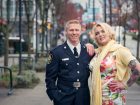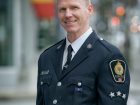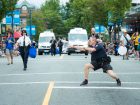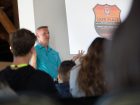
Features
A barrier breaker & builder of empathy: Const. Dale Quiring
When Velvet Steele, a well-known transgender and human rights activist, first met Vancouver Police Const. Dale Quiring, she was cautious.
May 23, 2018 By Renée Francoeur
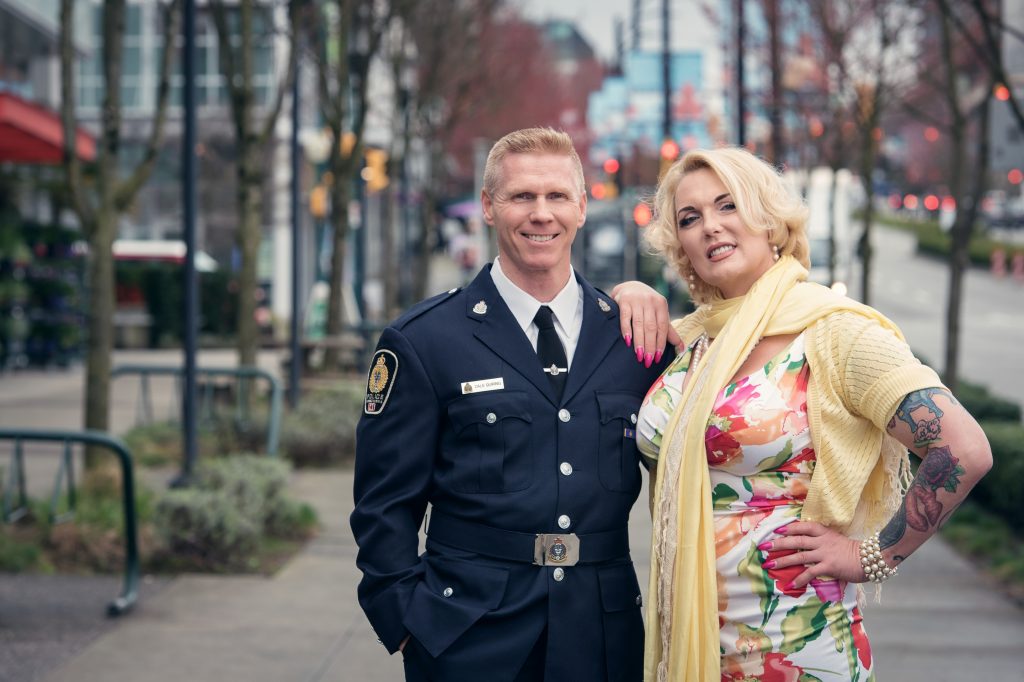 Activist Velvet Steele
Activist Velvet Steele “You could almost say it was like two cats in a room; one on one side and one on the other, backs against the wall,” she says with a laugh.
That didn’t last long, however.
Three years later, the two talk almost weekly and have travelled the country together, working to improve the relationships between police officers and the LGBTQ2S (lesbian, gay, bisexual, transgender, transsexual, queer, questioning, and two-spirit) community.
“Dale has really stepped up to the plate,” Steele says of Vancouver Police Department’s (VPD) first full-time LGBTQ2S liaison officer. “And not only as a compassionate individual, but also as someone who really wants to learn and takes the time to learn. It’s all been a very positive experience.”
Quiring has been selected as the 2018 recipient of Blue Line’s Police Leadership Award, which honours those with outstanding leadership skills, tireless dedication and who encourage others to develop similar pacesetting abilities. He has been credited for making major inroads with vulnerable and marginalized groups, especially the transgender community, and designing sensitivity training for fellow law enforcement officers.
Pioneering job
He is not only the first LGBTQ2S liaison officer in the VPD, but also in the entire province of British Columbia — as far as Blue Line could confirm. The pioneering job has taken him to various other police services, such as the Royal Newfoundland Constabulary, to pass on what he’s learned regarding LGBTQ2S issues in policing and how to work more collaboratively.
That’s the thing about Quiring, says Supt. Marcie Flamand, who was previously the inspector in charge of VPD’s Diversity and Indigenous Relations Section — he doesn’t limit things to Vancouver. He takes calls from outside the jurisdiction and is happy to help other police agencies rebuild relationships, whether that is through new policy creation or training updates.
“When I first went into that section, he was a hate crime investigator and I tasked him with making a transgender training video,” Flamand says. “It wasn’t in his job description but he took it on with such enthusiasm.”
It was that video — which been viewed almost 60,000 times on YouTube at the time of writing this —that would eventually fuel Quiring’s calling as an officially designated liaison officer.
Delivering on recommendations
After volunteering with the VPD victim services unit, Quiring was hired as an officer in 2001 and spent 12 years on the frontline before becoming a hate crimes detective in 2013. Sgt. Jeremy Johnson writes in Quiring’s leadership award nomination form that once he joined the Diversity and Aboriginal Policing Section, he wasted no time in forming new connections in communities prone to bias, prejudice and hate incidents.
In 2015, one of the subcommittees from the City of Vancouver’s LGBTQ2S Advisory Committee came to meet Quiring’s section after the B.C. Human Rights Tribunal ruled Vancouver police officers discriminated against a transgender woman. The tribunal found officers had used male pronouns to describe her in a police report and failed to provide her with proper post-surgery care while in custody.
“After we met with them my inspector asked me to help fulfill those recommendations,” Quiring says, noting he immediately started researching the suggestions that surfaced from the VPD’s 2008 Aaron Webster report (Webster was a gay man brutally beaten to death in Vancouver’s Stanley Park in 2001). These suggestions were based on previous community forums and centred on raising the bar in police basic training.
From there the “Walk with Me” video idea emerged as a platform to educate officers on transgender perspectives and issues. Quiring rounded up participants (which included Steele), scripted it and spent countless hours after shifts and on weekends to get the filming done.
The 17-minute video was shown to all VPD officers as a resource on how to better interact with a transgender person in a respectful manner, and it has since garnered international interest, according to VPD.
“This video acted as a final catalyst,” Johnson goes on to say in the nomination package. “Const. Quiring was soon considered not only a credible and trusted contact within the involved communities, but also a subject matter expert within the law enforcement community.”
Passion and understanding
Quiring was five years-old when he decided law enforcement was the career for him. This came after watching a uniformed police officer hot in pursuit, scaling the wall of a house near his childhood home in Kitchener, Ont. But as to what prompted him to carve out his own niche position and serve the LGBTQ2S community, it was two things.
“One was the Pulse Nightclub shooting in Orlando. I remember where I was when it happened and it truly broke my heart,” he says, referencing the horrific attack that saw 49 people gunned down at a gay club in Florida in 2016. “As I was growing this liaison position, I started corresponding via social media with some of the police officers in Florida and it only increased my drive and passion to work in the community. Two: it was through working on the ‘Walk with Me’ video and meeting as many trans folks as I did, especially Velvet Steele, and understanding their lives and what they go through, combined with a lot of the hate crime investigation I did. I don’t think people truly understand what they face on a daily basis, so it just pushed me to do more.”
At the same time, he says it’s important to recognize VPD has a chief who supports his passion and the community. Chief Adam Palmer “gets it,” and without that buy-in from the top, Quiring doubts he’d be able to do what he has so far.
After “Walk with Me” was launched in June 2016, Quiring formed the LGBTQ advisory committee for the Vancouver Police and things kept growing from there, he says, such as police policy reviews in tow with community consultation.
Inspired by a Seattle Police Department initiative, Quiring was also the main force driving the Canadian rendition of “Safe Place,” a program that provides a safe, easily identifiable and accessible location for LGBTQ2S members to go to if they are feeling unsafe or need assistance. Participating schools, businesses and other institutions can take part by displaying a rainbow-coloured decal in a visible place, such as a street-front window. They must also sign a pledge indicating their support and acknowledge their willingness to help.
Safe Place rolled out in Vancouver in July 2016 — the first of its kind in Canada — and currently more than 370 businesses proudly feature the decal, according to Quiring.
“The RCMP in B.C. have picked up Safe Place, too, and other municipal agencies across the country are starting the process to implement it,” he adds. “It’s continuing to grow.”
Quiring strongly believes that sensitivity schooling and community consultation go hand-in-hand with Safe Place, so he then developed a training package, specifically for frontline police officers, on how to be more empathetic towards the LGBTQ2S community. In it, he specifically points to transgender issues.
“I present that now to many different forces in the lower mainland and was invited to Newfoundland to present it,” he says. “It has resonated quite well.”
This was all happening while he was a hate crimes detective fulltime — working as this impromptu liaison officer on the side.
“He did so much in that role, upside of his desk as a hate crimes investigator, and so he wrote a proposal to get a whole new separate position up and running. This was to be solely dedicated to the LGBTQ2S liaison duties,” Flamand says.
“It started to consume a lot of my time and I knew it needed my full attention,” Quiring adds.
And so VPD’s first full-time LGBTQ2S liaison officer position was born in September 2017.
For Steele, that move truly put VPD in the driver’s seat.
“I hope it continues and that it is a long-term position,” she says. “I really believe the VPD is leading by example. They are getting out there in a community and we do see efforts to change; it’s slow but it’s there… I see the police as a child and the community as a parent. And a parent never gives up on the child.”
- Activist Velvet Steele
Beyond the uniform
The role has called for some innovative tactics to reach an audience with an unfavourable history of police interaction, Quiring says. Using Twitter, for example, has been a game changer, and every week he receives private messages from different people all over the country.
“What I tweet is very authentic. It’s my account. It’s all me and who I am. I’ve had many people tell me they’ve read my profile, watched my posts and can tell I’m someone they’d be comfortable speaking with. So that’s a very powerful medium, because they don’t know who they will get if they call the station. It’s a door opened for them.”
Controlling his own social media means he can get creative, which helps with relationship building.
“Trans people do not trust the police,” he explains. “As long as it’s not an emergency situation, many contact me through Twitter to engage and to meet up and from there more police support can be offered. They wont come to the police station but I can meet them at a coffee shop, for example. I do that quite often.”
And while he will be at that coffee shop out of uniform, he wants to be clear: he’s proud of his career.
“I’m very proud of my uniform and I love wearing it. We’re just going through a culture shift. These are issues that have been around for many, many years and the voices are finally being heard. We can’t push that back… These are hard topics and you’ve got to remember that a lot of these individuals have been marginalized and struggling for 25 years or more, so to have someone that they know is consistent and someone who cares, that’s the key. That’s when the trust starts to build and they see beyond the uniform.”
According to Steele, the police uniform can be triggering for many but she wants to work on getting people past that.
“Is the firefighter or EMS uniform triggering, too? Too many people want to hold onto negative experiences. People are reticent to deal with law enforcement but I ask: why aren’t you talking to them like you would a friend or a mother? There’s a person underneath that uniform.”
The uniform isn’t the only thing circulating in some backlash Quiring has received.
The first thing out of the critics’ mouths is: “Well, he’s not gay,” Steele says. “I really hate when people bash him. It’s about having allies and we need allies outside of our own communities. He’s such an easy guy to deal with. He’s certainly someone who engages in great active listening and his articulation comes across as very sensitive as well, a skill many people don’t have.”
Quiring knows many in the community are cautious because he is male.
“They do break through in one-on-ones… They keep me in check and that’s what we want. I fall back on my training and I just keep working and listening,” he says.
“A lot of people asked can a straight white male do this job?” echoes Flamand. “He’s proven that he good at it. As a constable, he’s making big changes. He was instrumental in helping create new policies and he was wise about it, consulting the people it will directly impact, getting the language right. He’s a man with a lot of emotion and he takes things to heart.”
Culture shift
Quiring hopes to continue working to break the barrier of bias and prejudice that some people feel towards the police.
He notes the culture at VPD has evolved in many ways over the past few years and it’s something Steele has also witnessed.
“I’ll be honest I didn’t know what was going on with VPD until Dale showed me more of what the diversity unit was trying to do,” she admits. “The outreach they’re doing to senior groups, youth groups, ethnic groups, religious groups — it’s mind-blowing. And I think most people think that, as a police officer, all you do is walk the beat or drive a car and go and arrest people. That’s not the case. They’re out there actually serving and protecting, so let’s figure that out more together. Let’s change the perception.”
Meanwhile internally, a healthy dialogue is unfurrowing in inclusive ways, and the agency is asking the right questions.
“It’s also not just about what’s outside in the community. It’s about what’s inside the police organizations, too,” Quiring explains. “We have gay officers, we have officers expressing differently. Officers may come out as transgender in the future. How are we prepared for that? How does that work? What supports do you have in place? Bathrooms, shower rooms, change rooms… So it’s opened up a wider conversation.”
The visibility of a fulltime LGBTQ2S liaison officer and the ensuing conversation has also promoted hiring practices, according to Quiring, and helped strengthen preparation for handling missing persons cases due to increased sensitivity.
“People want to work for an organization where the culture have shifted and that is the kind of culture we want to continue to foster.”
It doesn’t stop at Safe Place and sensitivity training. Quiring is currently involved in seeing “Walk With Me” translated into Chinese and Punjabi and he has a new campaign coming out this fall. He’s tight-lipped about what it will entail but does provide a clue: sports are involved and there will be a hashtag.
As for one of Quiring’s most memorable moments so far? It’s handing the 2016 Chief Constable’s Commendation he won over to Steele, who he says has been such a big influence, without a second thought.
“She proudly displays it in her home and for me, to see that happen with someone who did not trust the police for many years, for her to be at the ceremony with me… it was emotional and it created a bond between us,” he says. “That’s what it’s about.”
Print this page
